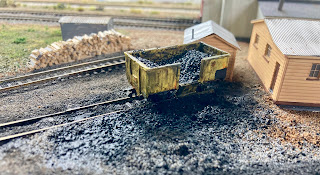DB makes a few poorly researched observations:
We NZ120 diesel modellers are pretty lucky, having a host of N scale chassis offerings that are a good-enough fit for most of our diesel locos. After a few months of pondering this Wb, I'm thinking steam is another matter!
Issues include:
- Driver size and spacing
- Wheel arrangement
- Cylinder location/connecting rods.
- Motion
- N scale vs our 1:120
- Power pickups and decoders
Driver size and spacing was well covered by Premier Duff in several posts.
wheel diameter real equivalent loco classes
7.5mm 3 F8mm 3'2" W, Wa, Wb, Wd
9mm 3'6" B, Ba, Bb
9.5mm 3'9" Wf, X
10mm 4' Ww, Aa, Q, U, Ub, Uc
11mm 4'4" A, Ab, Wab, K, Ka, Kb, J, Ja, Jb
12mm 4'9" G
More here Put the Kettle on , Steam pt 2 , Steam Part 3
I've noticed that many overseas steam prototypes, and thus models, have a larger gap between the two rearmost drivers (presumably to fit the firebox) whereas most of ours have consistently spaced drivers. Even my Alco Wb chassis has this 'feature' although its not too noticeable.
Because of N's 1:160 to 1:148 scale, the large drivers of racehorse overseas locos become reasonable for us to use in 1:120 on NZ's plodders.
While in theory, leading and trailing pony trucks can be subtly altered, this is easier said than done.
At the front this is hampered by the cylinder location, which can't really be moved because of the valve gear. This is an obvious fact that I hadn't even considered, so you usually can't replace a pony truck with a leading bogie, because there isn't enough space between the cylinders and the drivers (and the rods aren't long enough). Many of the models I've looked at online don't have the sort of room between the cylinders and the drivers we need - most of our locos have quite long connecting rods. This is partially exacerbated because they are in N rather than 1:120.
My Wb needs the leading pony truck moved forward, and a trailing one added. The pony truck that came with the model is a larger diameter than it should be but I have another smaller one off a Japanese steamer I may use, or I might just keep this one.
As for motion, other than our early inside framed locos and some later appearances of Baker valve gear, we were primarily in the Walschaerts camp for the bulk of our designs. My Wb should have inside valve gear, which means removing everything other than the main connecting rod and the distinctive Baldwin bowtie crosshead that my chassis does not have. A risky and painful operation given it is reasonably nicely modelled. I could leave the motion there, as I wouldn't have noticed before I started staring at Wb pics recently.
Ebb-Fettler has a 3d printed Ba loco top, needing a fairly narrow chassis, which made me dig out a pair of Japanese 2-8-0s that I was once going to turn into 2-foot six narrow gauge Chinese C2s with much larger scale tops. But these 'chassi' happen to have their connecting rods joined to the third rather than second driver! I'd never noticed this before last week. looking at the C2, that's how they are attached. So a fail for the Ba, but a win for the C2.
My Wb donor engine was a tender loco (a Bachman Alco consolidation). The tender has plenty of room for the supplied chunky hard-wired decoder, but that won't fit it into my little tank engine, so will have to be replaced with an ancient Digitrax Z scale decoder. The Pacific that I hope to turn into an Ab also has a big roomy tender which houses a long decoder board and a matching long speaker enclosure. Both of which will have to be shortened, as our tenders tend to be much, much shorter than American ones as our axle loadings restricted how much water/coal/oil we could carry. Shortening the tender without breaking too much will be a problem for another day. An A's square tender might be a better bet than the Vanderbilt one of the Ab.
The other issue with the need to remove the tender for the Wb... is that I'll be ditching 2/3rds of my power pickups, with the badly-laid-track-conforming tender bogies being sacrificed for a rigid six-coupled loco with traction tires on the front axle. Those rubber bands may have to be be removed. As for the possibility of picking up power from pony trucks. That would require engineering well above my pay grade.
So summing up the biggest challenge with steam in NZ120 for one without a CNC milling station and scanning electron microscope: With the 'modular' design of diesel models in the past, it was possible to swap out bogies from other loco types for different wheel arrangements, axle spacings and wheelbases, and even lengthening a chassis is possible. People have made custom chassis for NZ120 railcars for example. See also my DI with its reversed SD40-2 bogies in a GP30 frame. With steam, there seem fewer 'natural fits' for NZ prototypes, and modifying a loco chassis seems much harder, especially as they are 'advancing' with sound, miniaturised components and less user-serviceable designs. Or maybe its just a mental block plus my lack of experience with tiny wheeled kettles and micro-engineering.
So what chassis have other modellers used for NZ steamers, and what is your critical assessment of these in terms of fit, modifications needed, and performance? As with diesels, the limited runs that are produced these days probably make some of these old hens-teeth models real gems now. We could do with a steam loco chassis compendia like the diesel one referenced at the top of this...


























